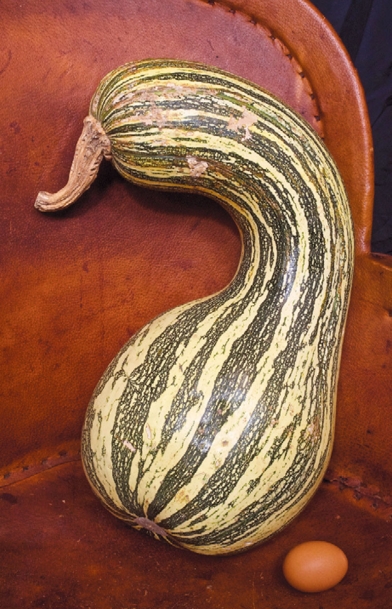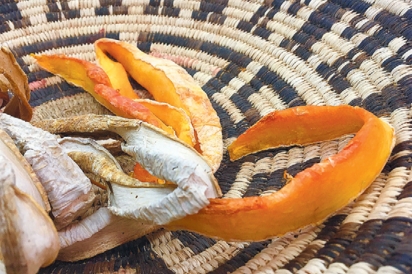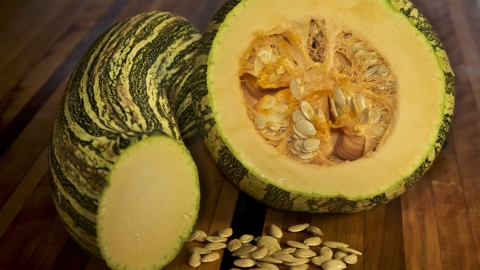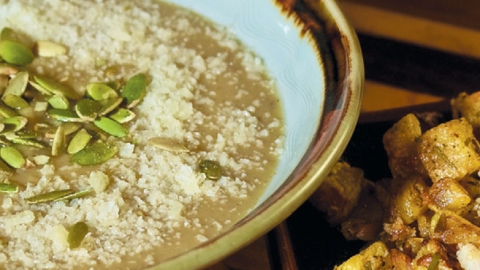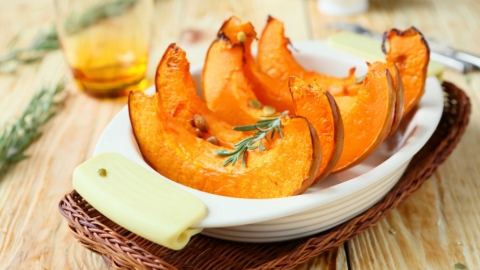The Big Squash Story
“The Mammoth Squash” Edgar A. Poe, 1845
The Mammoth Squash that Edgar Allan Poe wrote about could very well be a Green Striped Cushaw like the one I purchased at the Ajo Farmers market in early December. As big as a small child, it weighed 15 pounds and cost 35 cents per pound—a little over $5. A bargain indeed.
The squash family of vegetables originated in the New World and was domesticated as early as 8,000 years ago from wild gourds. It spread throughout the Americas before the arrival of Columbus, and throughout the world afterward. The multiple incarnations of squash include summer squash (like zucchini, crookneck and patty pan) and winter squash (which include pumpkin, butternut and acorn).
Summer squash are harvested about 50 days after planting and are immature, tender-skinned, white-fleshed fruits with undeveloped seeds. Winter squash, harvested at maturity in about 100 days, have hard skins, seeds with fibrous shells, and firm, yellow to orange flesh. Mature winter squash keep for three to six months without refrigeration. Both the flowers and the seeds of squash are edible and used widely in both ancient America and modern times. Indigenous people dried the flesh ryland used it when traveling.
Green Striped Cushaw is a long-vining winter variety that was selected over the millennia for both its immature and mature fruit, and for its edible flowers and seeds. It is a favorite hotoof Arizona’s first people, the people of the desert known as the Akimal O’odham and the Tohono O’odham, who call it “Ha:l.” Young fruit are picked when they are about the size of an avocado. Half are left on the vine to mature. Over centuries, the O’odham saved seeds selected for high productivity, heat and drought tolerance and resistance to the squash vine borer. It is extremely well adapted to Arizona’s southern deserts.
A slightly differently adapted Green Striped Cushaw is a much-loved heritage squash of Louisiana and the American South, where it is known as juirdmon or Tennessee sweet potato. The sweet orange flesh is prized for Cushaw pies and baked pumpkin Lafourche.
The Slow Food Foundation for Biodiversity recognizes the Green Striped Cushaw as a heritage vegetable, entered onto the Ark of Taste catalog as delicious, distinctive and facing extinction. Despite their great value and deliciousness, Ark of Taste foods like the Green Striped Cushaw are endangered because they are no longer widely grown. Modern cooks rarely use Cushaw, preferring smaller single-serving squash because they are more manageable. To preserve these heritage foods, Slow Food urges us to cook, enjoy, share and grow them.
Cut and Cook
When I brought home my own Green Striped Cushaw my first question was ... how do I cut this mammoth? I scanned YouTube and found a video of a woman chopping it with an axe. Yikes—and not necessary! Using my biggest chef knife, I found it not any harder to cut up than any other winter squash. Here is my approach:
• Cut the stem end off. Cut the neck into three pieces and cut off the rind, leaving the bulb whole
• Now the neck can be cut into cubes or larger pieces for recipes. Cubes or pieces can be steamed or roasted for use.
• Cooked pieces can be puréed and used wherever canned pumpkin is called for or frozen for further use.
• Take the bulb and scrape out the seed cavity with a spoon. Rinse the seeds in a colander, discard the surrounding pulp, and retain the seeds for toasting or dry them for planting.
• From the bulb, make traditional dried Ha:l or cut it into pieces to roast.
This whole process took me two days. If you don’t want to do this all at once, wrap the unused raw squash portions and refrigerate them. They’ll keep for up to a week.
Time to Plant
The spring soil is almost warm enough for me to plant my own Green Striped Cushaw. I can’t wait to see it grow, grow, grow. Think of all the fun you can have with your family over this project: “Gosh! ’T is a most enormous squash.” I’m going to grow more than I can use and give some to my friends. I can’t wait to see their faces when I deliver the squash and challenge them to use it.
The Green Striped Cushaw I purchased was grown by farmer Frank Martin from Crooked Sky Farms. I called him and pumped him for growing information. He told me they were easy to grow, extremely well adapted to desert conditions, bug resistant and bullet-proof. Here’s the scoop:
Seeds: Widely available. See Resources sidebar for sources. Space: Choose a spot with about a four-foot diameter for the seed bed. The runners can grow up to 30 feet long, so allow some growing space around. (I think this would do very nicely in the middle of a city lawn.)
Soil: Add a bag of well-composted soil or steer manure and dig it in. Water deeply.
Plant: When the soil temperature is 70°, mid-March to mid-April. Plant six seeds one inch deep and two to three feet apart. Cover with a light mulch and keep moist. Seeds will sprout and leaves will appear in six to 12 days. Thin to the strongest two or three plants.
Care: Keep weed free and water slow and deep. Seedlings will need water every three or four days. As the plants grow they will need water less often. Water deeply. Trickle water a from a hose every seven to 10 days. If you start with good soil you will not need to fertilize these plants.
Harvest: Young squash in about 50 days, when they are the size of an avocado. They’re used like zucchini but are sweeter with a nutty taste. Mature squash are ready in 100–120 days, when the rinds are too tough to scratch with your fingernail. You should get three to five big squash per hill. The average size is 15 pounds, but Frank has seen some up to 50 pounds. That’s scary, but Frank says, “It’s really a lot of food for a small investment.”
Storage: Cured squash held in a dry place at room temperature will keep for months. Put one on the dining room table for a sculptural effect. Frank says he used to carry them around in his truck for a year and they were still good eating!
If you can’t grow your own, ask Farmer Frank to grow one for you. Catch him at the farmers market or contact him through crookedskyfarms.com.
RESOURCES
Seed sources:
Native Seed/Search: nativeseeds.org
Baker Creek Heirloom Seeds: rareseeds.com
Johnny's Selected Seeds: johnnyseeds.com
Further information and recipes:
Slow Food Ark of Taste: slowfoodusa.org
Savor the Southwest blog: savorthesouthwest.wordpress.com
Foods of the Southwest Indian Nations by Lois Ellen Frank (Ten Speed Press, 2002)
TRADITIONAL DRIED CUSHAW: O’ODHAM HAHA:LSAD
Thanks to Amy Juan from the San Xavier Co-Op Farm for her guidance on process
Traditionally the dried Cushaw strips are cut from the bulbous base of the squash. After you have removed the seeds, cut off most of the thick rind, leaving a cap of skin with about a 5-inch diameter on what was the bottom of the squash. Traditionally this bulb is hung upside-down on a post where it can get plenty of air for 2-3 days. Then the squash is sliced in a spiral about 1/3-inch thick and hung over a line to dry. When the spirals are leather hard they are gathered into bundles and stored for quick use.
Because I live in the wetter, colder high country, I cut off all of the rind, cut thin slices of the squash and dried them in a food dehydrator set on low. They took 12 hours to reach the correct consistency. You could easily dry them on trays with a fan blowing over them or in a convection oven with a fan. Dry to leather hard. Wrap and store in a cool dry place.


